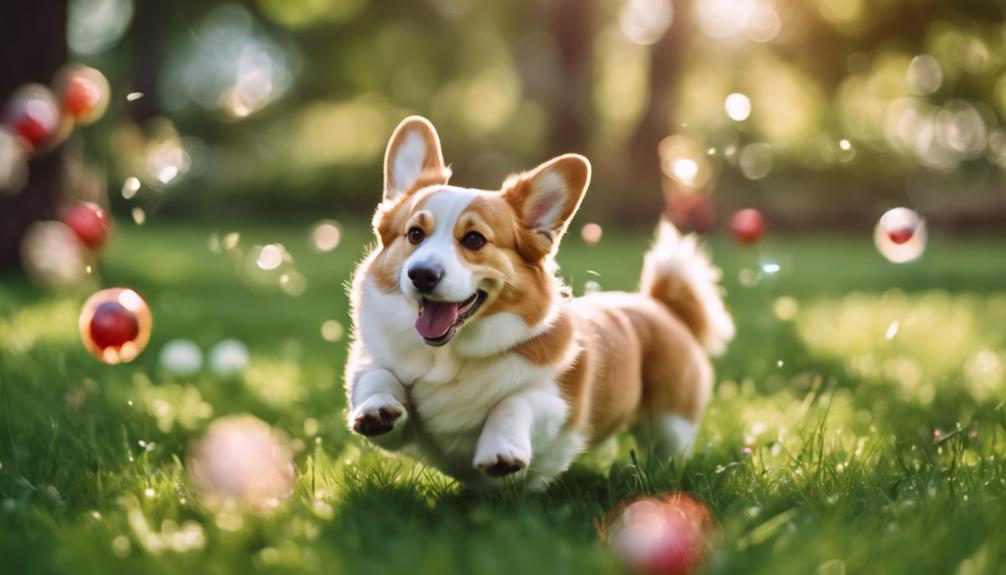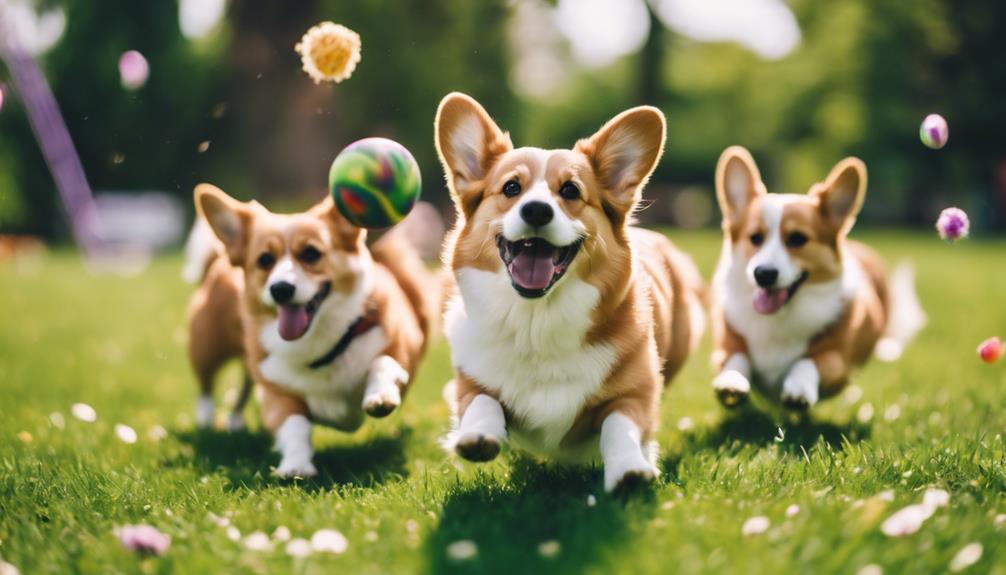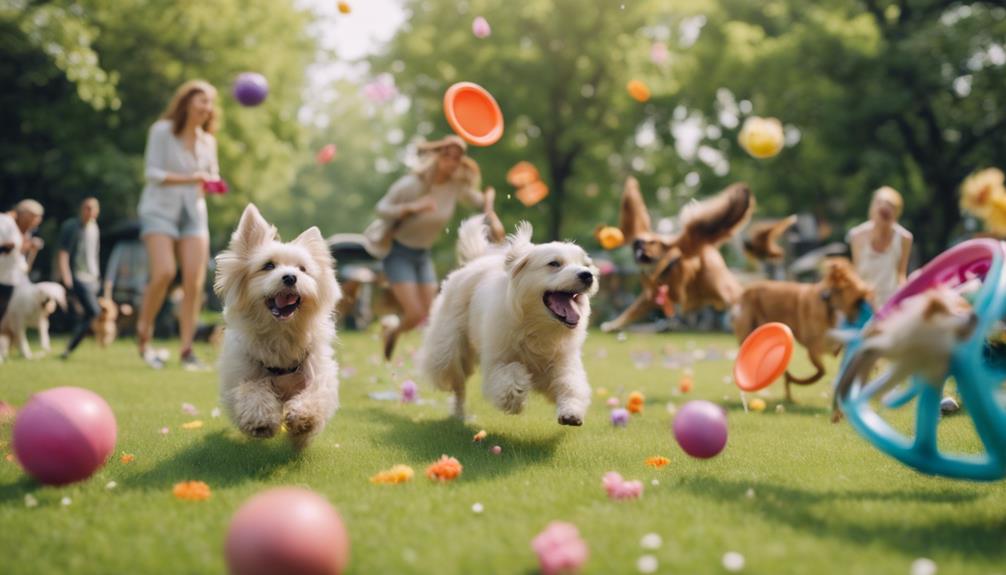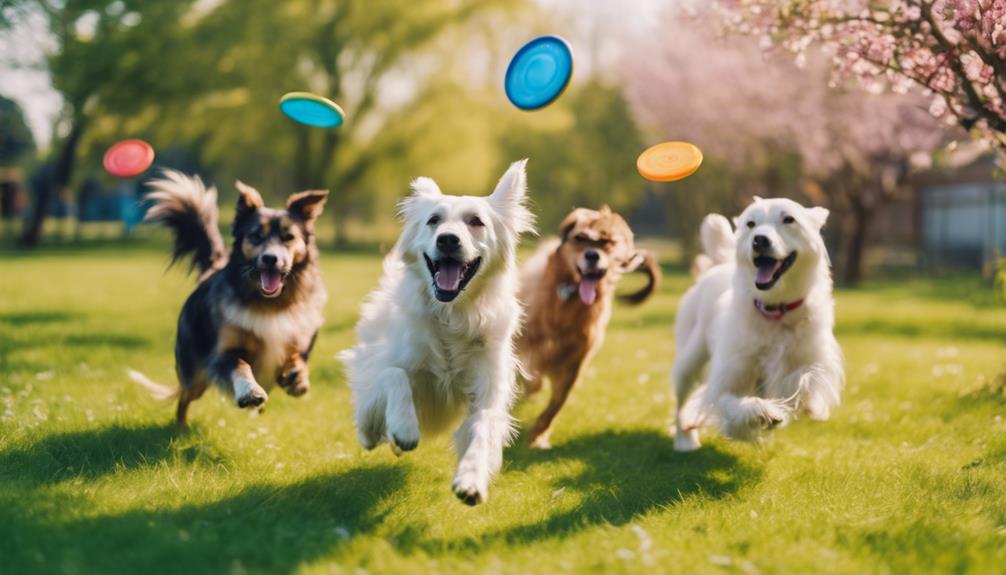The playful nature of Corgis is a nuanced aspect of their behavior that reflects both their herding heritage and their innate sociability. These dogs exhibit a remarkable blend of energy and intelligence, which manifests in various playful activities that not only entertain but also support their overall well-being. By examining their unique traits and social interactions, we can gain valuable insights into effective engagement strategies that enhance the owner-pet relationship. However, understanding the intricacies of their body language may reveal even more about their playful inclinations and the underlying needs that drive them.
Corgi Playfulness Defined

Corgis are renowned for their exuberant playfulness, characterized by a combination of boundless energy, intelligence, and a unique sense of humor that captivates both their owners and fellow canines.
These dogs exhibit several corgi personality traits that enhance their playful behaviors. They are highly social animals, often seeking interaction with both people and other dogs. Their eagerness to play is evident through their enthusiastic barks and playful nudges.
Corgis also demonstrate a strong desire to participate in games like fetch or tug-of-war. Additionally, their intelligence allows them to quickly learn new tricks, further enriching their playful interactions.
This blend of personality traits makes Corgis not only entertaining companions but also highly engaging pets for families.
Unique Traits of Corgis
Renowned for their distinctive appearance and charming personalities, Corgis possess a unique combination of traits that make them stand out among dog breeds. These small, sturdy dogs have short legs and long bodies, which gives them a playful yet confident stature.
Corgis have a rich history, tracing back to Wales, where they were originally used as herding dogs. This background contributes to their energetic nature and strong work ethic.
There are two main corgi breeds: the Pembroke Welsh Corgi and the Cardigan Welsh Corgi. Each breed has its own characteristics, but both share a friendly disposition and intelligence.
Their loyalty and eagerness to please further enhance their appeal, making them cherished companions for families everywhere.
Social Interactions With Other Dogs

Understanding social interactions with other dogs is essential for fostering a harmonious environment, as it influences behavior and overall well-being in canine companions.
Dog park dynamics play a crucial role in how dogs engage with each other. At these parks, dogs communicate through body language, vocalizations, and play behaviors, which are vital for establishing social hierarchies and friendships.
Key aspects of canine communication include:
- Posture: Dogs display confidence or submission through their stance.
- Tail Wagging: A wagging tail often indicates excitement but can also signify anxiety.
Recognizing these signals enhances understanding and promotes positive interactions, ultimately benefiting both dogs and their owners.
Playtime Activities Corgis Enjoy
Among the various breeds of dogs, Corgis are particularly known for their energetic and playful nature, engaging in a range of activities that stimulate both their physical and mental well-being.
One popular activity for Corgis is fetch games, where they eagerly chase after balls or toys, providing excellent exercise while fostering a strong bond with their owners.
Additionally, agility courses present another enjoyable option; these courses challenge Corgis to navigate obstacles like tunnels and jumps, enhancing their coordination and confidence.
Incorporating these playtime activities not only keeps Corgis entertained but also promotes their overall health.
Importance of Exercise for Corgis

Regular exercise is crucial for Corgis, as it not only supports their physical health but also plays a vital role in their mental well-being.
Engaging in regular corgi exercise helps maintain their weight and strengthens their muscles, which is essential for their short legs and long bodies. Additionally, consistent activity fosters better behavior by reducing anxiety and boredom.
To ensure optimal corgi fitness, consider incorporating the following activities:
- Daily walks: Aim for at least 30 minutes to keep them active.
- Interactive play: Use toys that encourage jumping and running.
Understanding Corgi Body Language
Understanding Corgi body language is essential for recognizing their emotions and needs.
Key indicators include tail wagging, which can signal excitement or happiness, as well as the position of their ears and expressions in their eyes, which can reveal their mood or alertness.
Tail Wagging Signals
Tail wagging in Corgis serves as a vital communication tool, conveying a range of emotions and intentions to their human companions and other animals.
Understanding these tail movements is essential for interpreting their feelings and behaviors accurately. Corgis utilize tail communication to express various emotional cues, which can help strengthen the bond between the dog and its owner.
- A high, fast wag often indicates excitement and happiness.
- A slow wag at a lower position may signal uncertainty or submission.
Ears and Eye Expressions
Ears and eye expressions play a crucial role in conveying Corgis' emotions and intentions, offering insights into their mental state and enhancing the communication between dogs and their owners.
Corgis have distinctive ear expressions that can indicate various feelings. For instance, perked ears often signal curiosity or excitement, while relaxed ears may suggest calmness.
Eye communication is equally important; wide-open eyes can show surprise or fear, while narrowed eyes often indicate focus or determination. Understanding these signals helps owners respond appropriately to their Corgis' needs.
By observing both ear expressions and eye communication, owners can foster a stronger bond with their dogs, ensuring a happier and more harmonious relationship.
Thus, recognizing these cues is essential for effective interaction.
Tips for Engaging Playtime

To foster a more enriching playtime experience for dogs, it is essential to incorporate activities that stimulate both their physical and mental capabilities.
Utilizing interactive toys can significantly enhance engagement, as they encourage problem-solving and curiosity. Additionally, exploring fetch variations, such as using different types of balls or incorporating obstacles, can keep the game exciting and physically demanding.
Consider the following tips for effective playtime:
- Rotate Toys: Frequently change the toys available to your dog to maintain interest.
- Incorporate Training: Use play as an opportunity to reinforce commands, making learning fun.
These strategies promote a joyful and stimulating play environment for your dog.

